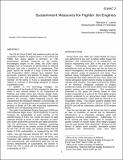| dc.description.abstract | The US Air Force (USAF) has evolved a policy for the
acquisition of fighter jet engines (FJE). In the 1970s and
1980s that policy placed a premium on FJE
performance primarily measured by the metric:
thrust/engine weight. In the 1990s, the USAF policy
changed from an emphasis on performance to reduced
life-cycle cost with a premium on sustainment. This
paper reports the results of a study of how the USAF
and Corporation Alpha (Alpha) have adapted their
processes, practices, and policies to design, develop,
manufacture, test, and sustain a family of FJEs. Each
member of the family of FJEs is sequentially linked
relative to insertion of technology designed to reduce
sustainment costs.
In addition to the technology linkages, the
development of the family of FJEs selected for this case
study is also tracked relative to US Department of
Defense and USAF policy and industry design, build,
and maintain processes, methods, and tools. This paper
discerns the complex, highly integrated manner that
characterizes the interaction between (1) technology, (2)
policy, and (3) manufacturing and sustainment tools to
produce a family of FJEs with improving sustainment
qualities and non-degrading performance.
The metric Unscheduled Engine Removals (UER) per
1000 Effective Flight Hours (UER/1000EFH) is used to
compare the sustainability of each member of the
selected family of FJEs. Our results are based on data
obtained through a series of field interviews of USAF
and civilian government personnel and Alpha personnel.
The US government extensive database containing
UER information is the primary source of MRO trends
for the FJEs of this study. Our analysis shows that the
family of FJEs sustainability, as measured by the UER
metric, has not improved beyond 6 10 EFH for each
succeeding generation in the selected FJE family. We
conjecture that upstream policy, technology insertion,
and manufacturing and sustainment tools are not the
primary determinants of sustainability; the manner in
which the FJE is used has the greatest influence on
sustainability of FJEs. | en |
